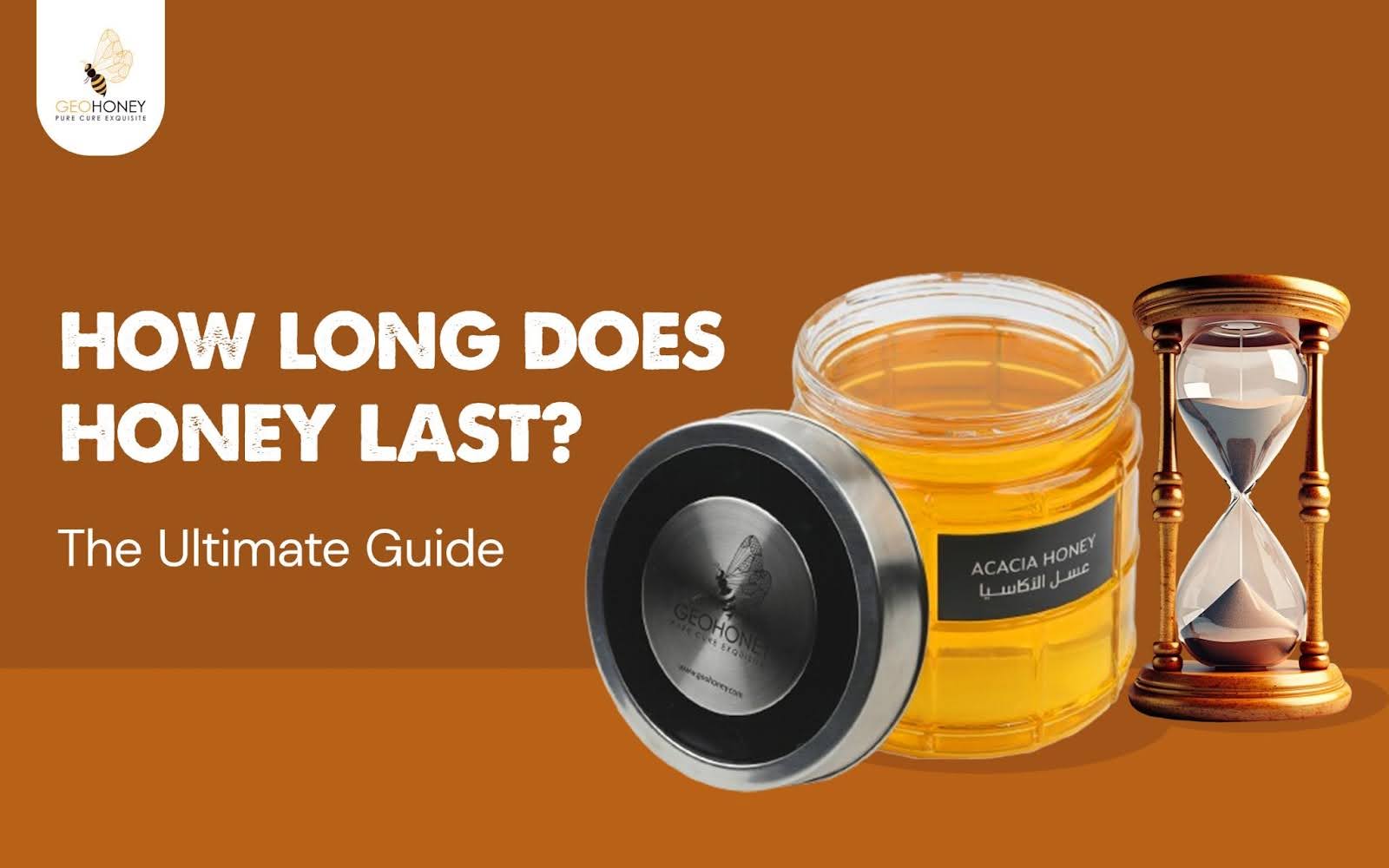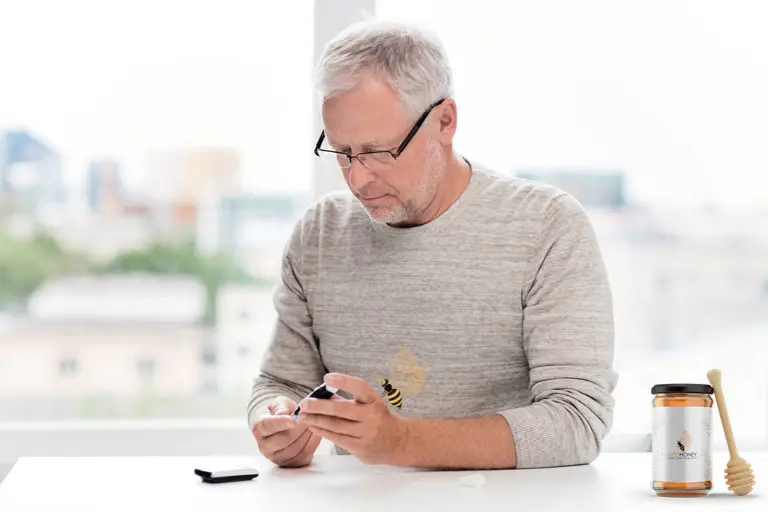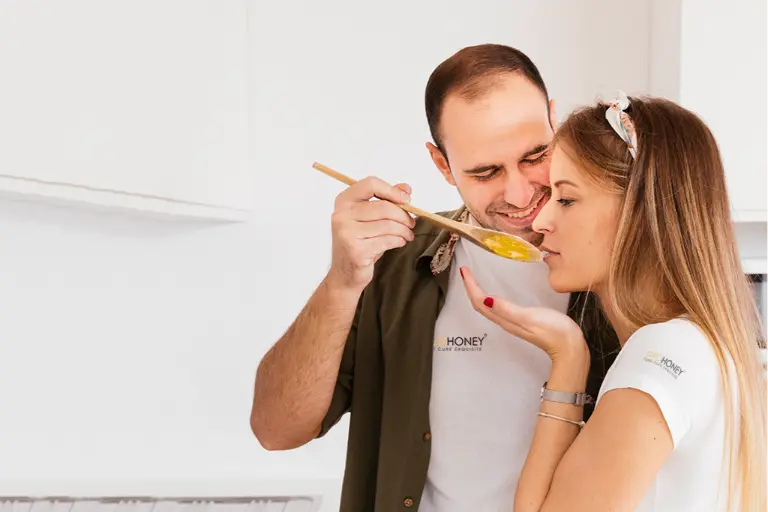- Tokyo: 06:44
- Singapore: 05:44
- Dubai: 01:44
- London: 21:44
- New York: 16:44
How Long Does Honey Last? The Ultimate Guide

Humans and honey have a connection that is as old as time. This natural sweetener is known for its nutritional wonders, flavor and long shelf life. But how long does honey last before losing its original flavor and texture? This is a question that often bothers honey lovers.
This is what the founder of Geohoney and the CEO of B A Barry Group, Mr. Basem Barry has to say.
“Honey is among very few natural items that don’t go bad under normal conditions. In fact, some historical records show it has been perfectly preserved for thousands of years in ancient tombs.”
This blog lists some useful facts about the shelf life of honey. This information will help you understand what makes raw honey last a long time without losing any of its health benefits so keep on reading till the end.
How Long Does Organic Honey Last?
Reasons Why Honey Lasts for a Long Time
High Sugar and Low Moisture Content
Acidic Nature
Naturally Antimicrobial
Natural Enzymes
Signs That Show Your Honey Has Spoiled
Factors That Affect Honey’s Shelf Life
Contaminations
Presence of Toxic Compounds
Adulteration
Poor Storage Conditions
Crystallization and Degradation
Tips to Properly Store Honey to Ensure It Lasts Long
How Long Does Organic Honey Last?
The simple answer is: a very long time. In fact, archeologists have unearthed jars of honey from ancient Egyptian tombs that date back to 3000-5000 BC. This is what led most people to believe that organic honey can never go bad and this is true to some extent.
Under the right conditions, honey can stay edible indefinitely. However, things like the addition of additives, the presence of contaminations and poor storage can significantly reduce its shelf life.
Honey’s impressive shelf life can be attributed to its unique composition that involves antibacterial elements, low moisture and high sugar content. Over time, you might notice changes in the honey’s color and texture. This, however, is usually an indication of honey crystallization which is often mistaken as honey gone bad.
This is not true since crystallization doesn’t spoil honey. In fact, you can easily reverse it by putting the jar of honey in warm water.
However, exposure to very high heat and moisture can lead to fermentation and spoilage of honey which is why storing it properly is extremely important.
Reasons Why Honey Lasts for a Long Time
Following are a few factors that lead to an impressively long shelf life of honey
High Sugar and Low Moisture Content
Honey contains about 80% of sugar and only 17% to 20% of moisture or water. The low water content creates inhospitable conditions for bacteria or mold which need water to grow. Moreover, the high density of the organic honey doesn’t allow oxygen to enter which deprives bacteria of this essential element thus ensuring honey’s purity for a long time.
Acidic Nature
During the nectar ripening, gluconic acid is produced which gives honey a very high acidity of 3.4-4.5. This acidic environment inhibits the growth of C. diphtheriae, E. coli, Streptococcus and Salmonella bacteria.
The presence of hydrogen peroxide also gives antibacterial properties to the honey. The presence of oxalic, citric and malic acids in honey further deters the growth of microorganisms. These components act as natural preservatives that extend honey’s shelf life considerably.
Naturally Antimicrobial
Honey has antimicrobial features that can be attributed to its low pH and the presence of compounds like hydrogen peroxide, polyphenols, phenolic acids, flavonoids and methylglyoxal. These components prevent the growth of foodborne pathogens and food spoilage organisms. This is another factor that gives honey a longer shelf life.
Natural Enzymes
Raw natural honey also contains an enzyme called glucose oxidase. This compound converts sugar into gluconic acid and produces hydrogen peroxide. The presence of this enzyme further protects honey against spoilage.
Signs That Show Your Honey Has Spoiled
Honey can stay edible indefinitely given that you take the correct storage measures. Failure to do so can lead to spoilage. Following are the main signs that indicate honey’s spoilage
If your honey changes from consistent light amber or dark brown color to unusual dark colors with a cloudy appearance, it might have gone bad.
If you notice separation in the layers of the honey, it indicates fermentation and spoilage.
The presence of a sour or fermented smell also indicates honey’s spoilage.
The flavor of honey turns sharp, sour and off-putting once it goes bad.
If you notice a gritty texture with very large and hard crystals, it shows the honey has spoiled.
If you notice a fuzzy or powdery mold-like growth on the honey’s surface, it also indicates spoilage.
Factors That Affect Honey’s Shelf Life
The following are the main factors that can reduce the shelf life of your honey.
Contaminations
The honey might get contaminated during its processing. It can be affected by microorganisms resulting from interactions with wind, dust, insects, water and processing equipment. Over time, it can significantly reduce the shelf life of the honey.
Presence of Toxic Compounds
The nectar from certain flowers contains toxins. These toxins can be transferred to honey, shortening its life. For example, the presence of grayanotoxins in the nectar of Rhododendron ponticum and Azalea pontica plants not only destroys honey’s health benefits but also leads to spoilage.
Adulteration
The addition of cheap sweeteners like sugar syrups from maize or beet sugar to the honey leads to unbalanced water content. These sweeteners are added to honey that has not yet been completely formed. This honey has a higher water content which promotes fermentation and an off-putting flavor.
Poor Storage Conditions
If the honey containers are improperly sealed, it can allow moisture to get absorbed into the honey which raises water content. Open jars also invite microbes that can accumulate over time spoiling the honey forever.
Moreover, if the storage temperature is too high, it can also lead to color degradation and a loss of flavor of the honey.
Crystallization and Degradation
Over time, your honey can become opaque and grainy. This is a clear sign of crystallization. During crystallization, honey releases water which can lead to fermentation. This is why you need to immediately get rid of the crystallization by heating the jar of honey in warm water. Doing this will return the honey to its normal state.
Apart from crystallization, honey can also naturally degrade over time. This leads to a loss of aroma and flavor. Though it doesn’t necessarily indicate spoilage, some people still prefer to replace the honey to get the desired flavor.
Tips to Properly Store Honey to Ensure It Lasts Long
Here are a few things you can do to ensure your honey preservation for a long time
Store the honey in airtight glass jars or stainless-steel containers.
Store the honey at a temperature below 50°F (10°C) in a cold and dry place.
You can also store it at room temperature i.e., 50–70 °F (10–20°C).
Do not use dirty spoons, knives or other utensils while taking the honey out of the jar.
Use dark-colored or opaque containers to protect the honey from light exposure.
Conclusion
Honey has a remarkable shelf life owing to its very low water content, high sugar content and the presence of antibacterial elements. When stored properly, this sweet treat can stay edible and fresh for a lifetime.
On the other hand, storing it in a warm and moist place without proper sealing can lead to spoilage which is indicated by bad odors, tastelessness and the growth of mold.
This is why you need to maintain ideal storage conditions to ensure the honey does not go bad any time soon.
You can visit Geohoney today to explore our wide range of pure monofloral and wildflower honey varieties to get both an amazing flavor and several health benefits all in one.



